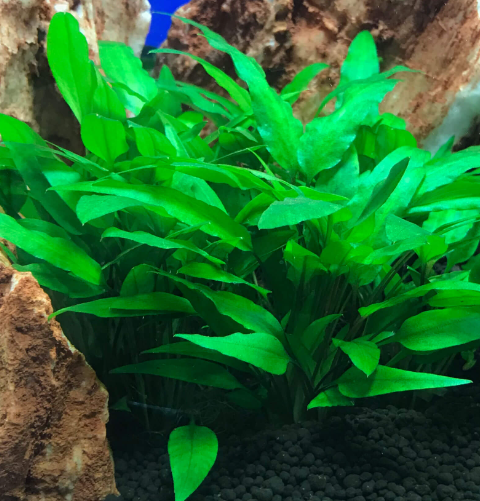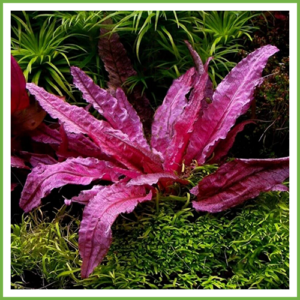Description
Cryptocoryne Wendtii Green


Overview
Cryptocoryne wendtii Green is a popular and versatile aquatic plant that is highly valued in the aquarium hobby. It belongs to the Araceae family and is known for its hardy nature, making it a favorite among both beginner and experienced aquarists. This plant originates from Sri Lanka, and its ‘Green’ variety is one of several different colour variations within the Cryptocoryne wendtii species.
Like other crypts, this plant is recommended for beginners due to its ease in keeping and low care requirements. If grown in good aquarium substrate, the plant can feed through the roots and grow quickly without the need for high light, CO2 or fertilizer dosing. Light plays a decisive role in the growth habit of this variety. Lots of light results in a horizontal leaf position, whereas little light prompts it to grow vertically.
Crypts can be grown emersed or submerged. Propagate by splitting the rhizome or cutting off new growth and replanting.
Tissue culture plants are grown in vitro from a state of the art laboratory specialized in propagating aquatic plants. This means you can enjoy strong and healthy plants free from pests and diseases from the start.
Care Requirements
Lighting: Low to moderate lighting (5-20 µmol PAR). High light can promote faster growth but isn’t necessary.
Water Parameters:
- Temperature: 20-28°C.
- pH: 6.0-8.0 (slightly acidic to slightly alkaline).
- Hardness: Soft to moderately hard water (3-15 dKH).
Substrate: Nutrient-rich substrate like aquarium soil or laterite is ideal, as Cryptocoryne wendtii is a root feeder. However, it can grow in gravel or sand with root tabs or liquid fertilizers.
Nutrients: Benefits from regular dosing of liquid fertilizers (e.g., iron, potassium) or root tabs for optimal health and colour.
CO2: Not required but can enhance growth in high-tech setups.
Tank Requirements: Ideal for low to medium-tech aquariums due to its adaptability.
Planting and Propagation
Planting:
- Plant the roots gently into the substrate, leaving the crown (where leaves meet roots) exposed to prevent rot.
- Space plants 5-10 cm apart to allow for runner growth.
Use tweezers for precise planting in aquascaping.
Propagation:
- Cryptocoryne wendtii propagates naturally via runners (horizontal stems) that produce plantlets.
- Once plantlets develop roots and a few leaves, they can be carefully separated from the mother plant and replanted.
- Division of mature clumps is another method, but handle roots carefully to avoid damage.
Maintenance
- Trimming: Remove yellowing or decaying leaves by cutting at the base to maintain aesthetics and prevent water quality issues.
- Fertilization: Add root tabs every 3-6 months or liquid fertilizers weekly, depending on tank setup.
- Cleaning: Gently vacuum around the base during water changes to remove debris without disturbing roots.
- Water Changes: Perform regular water changes (20-30% weekly) to maintain stable parameters, as Cryptocoryne species are sensitive to sudden changes.
Challenges and Tips
Challenges:
- Crypt Melt: Cryptocoryne wendtii may shed leaves when introduced to a new tank or after parameter changes. This is normal, and new growth typically appears within weeks.
- Slow Growth: Growth can be slow, especially in low-light or nutrient-poor conditions.
- Algae Growth: In high-light setups, algae may grow on leaves if nutrients are imbalanced.
Tips:
- Avoid frequent replanting, as Cryptocoryne species dislike root disturbance.
- Maintain stable water parameters to prevent stress and melting.
- Pair with fish that won’t uproot or eat the plant.
- If algae appears, reduce light duration or intensity and use algae-eating species like otocinclus.
Recommendation
- Combine with other Cryptocoryne varieties (e.g., C. wendtii ‘Bronze’ or C. parva) for a varied aquascape.
- Place in midground or foreground areas to create a lush, natural look.
- Suitable tank mates: Small, peaceful fish (e.g., tetras, rasboras) and invertebrates.
- For best results, use a nutrient-rich substrate like Aqua Soil or supplement with root tabs in inert substrates.
- Monitor for signs of nutrient deficiency (yellowing leaves) and adjust fertilization accordingly.







